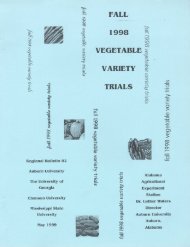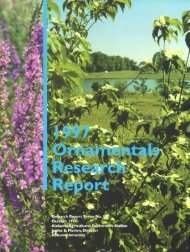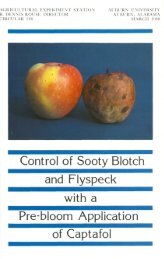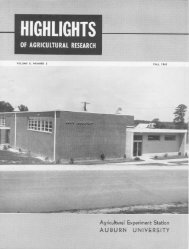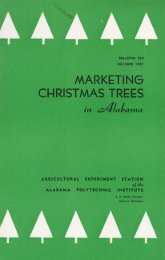-~i~ 4 A - Auburn University Repository
-~i~ 4 A - Auburn University Repository
-~i~ 4 A - Auburn University Repository
Create successful ePaper yourself
Turn your PDF publications into a flip-book with our unique Google optimized e-Paper software.
IN 496<br />
7. ~"<br />
i-. 4<br />
-'4- '<br />
)<br />
b-h<br />
'~'~i ~.<br />
'Vt -<br />
- ~ ff44<br />
C' U y-'~;';.c-<br />
''4.' .t<br />
44 .4 4 -.<br />
'4' 4' a ~.<br />
A' ~> t~j2.~ .4'4~<br />
* . 4 ~4 -j<br />
4 , -<br />
'4<br />
4.<br />
Y<br />
A<br />
-<strong>~i~</strong> 4 A<br />
OCTOBER 1977<br />
ky<br />
'4" ~i,<br />
R<br />
- ... 4<br />
4'<br />
.<br />
7i<br />
r' £~<br />
~7 '-P<br />
;.4<br />
* ~'' V<br />
2k.<br />
.4<br />
-4g<br />
4'. -<br />
f-C-<br />
444;<br />
~ 4~ ~<br />
~,c' ~<br />
a,<br />
;f/<br />
4 -*<br />
qv%<br />
C<br />
?<br />
.4%<br />
- P.<br />
4W<br />
* ' -4<br />
~<br />
AGRICLTLULRAL E XPFRIMFNT STLATION ALBLURN U NIVERSITY<br />
R. DENNIS ROUE, D IRE(CTOR AU BURN, AL ABAMA<br />
4~444<br />
jl A;<br />
r'v<br />
W<br />
W<br />
cJ-<br />
Q<br />
cm
CONTENTS<br />
Page<br />
EXPERIMENTAL PROCEDURE . . . . . . . ............................... 3<br />
Pasture Management ................................<br />
Management of Grazing Animals ........................<br />
RESULTS AND DISCUSSION ...................... ... .. .... 5<br />
Pastures. ............................ 5<br />
Cattle Performance ..................................<br />
6<br />
SUM M ARY ........................................... 9<br />
LITERATURE CITED.. . . . . . . . . . .................................... 11<br />
FIRST PRINTING 5M, OCTOBER 1977<br />
Information contained herein is available to all without regard to race,<br />
color, or national origin.<br />
4
Overseedin Winter Annual Forages<br />
on Coastal Bermudagrass Sod<br />
for Beef Cows and Calves<br />
C. S. HOVELAND, W. B. ANTHONY, J. A. McGUIRE, and J. G. STARLING'<br />
WARM SEASON PERENNIAL grasses, such as Coastal bermuda, are<br />
dormant or unproductive in southern Alabama for 5 to 6 months of the<br />
year (7). Overseeding winter annual clovers on such grass sods can<br />
extend the grazing season by 4 to 8 weeks (5) and improve beef calf<br />
gains (1, 3, 4). Close clipping or grazing to remove old grass residue in<br />
autumn is necessary to obtain good clover establishment and early production<br />
(6, 9).<br />
Overseeding rye and clover on Coastal bermuda sod can extend the<br />
grazing season, but forage yield of the winter annuals is less when sodseeded<br />
than when planted on prepared land (8). Rye provides earlier<br />
grazing than clover alone on sod. Steer gains have averaged 1.5 to 2.0<br />
pounds per day with rye overseeded on Coastal bermuda (2, 10). However,<br />
no beef cow-calf grazing data are available comparing overseeding<br />
of various winter annuals on Coastal bermuda with grass sod alone in<br />
southern Alabama.<br />
EXPERIMENTAL PROCEDURE<br />
This report summarizes the results of beef cow-calf performance<br />
over 3 years at the Wiregrass Substation, Headland, Alabama, on four<br />
pasture swards: (1) Wrens Abruzzi rye (Secale cereale), Yuchi<br />
arrowleaf (Trifolium vesiculosum) clover, and Autauga crimson<br />
(Trifolium incarnatum) clover overseeded on Coastal bermuda<br />
(Cynodon dactylon) sod; (2) Yuchi arrowleaf and Autauga crimson<br />
clovers overseeded on Coastal bermuda sod; (3) Gulf ryegrass (Lolium<br />
'Professor, Department of Agronomy and Soils; Professor, Department of Animal and Dairy<br />
Sciences; Associate Professor, Department of Research Data Analysis, and Superintendent,<br />
Wiregrass Substation.
4 ALABAMA AGRICULTURAL EXPERIMENT STATION<br />
multiflorum) overseeded on Coastal bermuda sod; and (4) Coastal<br />
bermuda sod alone.<br />
Pasture Management<br />
An established sod of Coastal bermuda on Norfolk fine sandy loam<br />
soil was used as the basic sward. The 1.75-acre paddocks had been used<br />
in earlier grazing trials. The grazing paddocks were randomly assigned<br />
treatments for this experiment as follows:<br />
Three paddocks overseeded with rye and clover<br />
Three paddocks overseeded with clover only<br />
Two paddocks overseeded with ryegrass<br />
Two paddocks not overseeded (control)<br />
The grass sod was grazed closely each year in early October. Paddocks<br />
to be seeded were scarified with a disk. Rye-clover paddocks were<br />
planted with a grain drill in mid-October. Clover-only and ryegrass<br />
paddocks were seeded on undisturbed sod in November. Seeding rates<br />
per acre were 1 bushel rye, 8 pounds Yuchi arrowleaf clover, 10<br />
pounds Autauga crimson clover, and 20 pounds Gulf ryegrass.<br />
Nitrogen at 50 pounds per acre was applied to the Coastal bermuda<br />
control plots (non-overseeded) in early April and July to total 100<br />
pounds N annually. The ryegrass treatment received 50 pounds N per<br />
acre in January, April, and July, to total 150 pounds annually. Ryeclover<br />
received 50 pounds per acre N in November and January, to<br />
total 100 pounds annually. The overseeded clover treatment did not<br />
receive any nitrogen fertilizer. Lime and mineral fertilizer were applied<br />
to all forage species according to soil test recommendations.<br />
Management of Grazing Animals<br />
Grade Hereford and Hereford-Charolais cows bred to crossbred<br />
Charolais bulls were used. Calves, born from November through<br />
December, remained with the cows until weaned in September.<br />
Whenever grazing was available, each 1 3/4-acre paddock was<br />
stocked with a cow-calf unit. Additional cow-calf units were added<br />
during peak periods of pasture growth. These animals were maintained<br />
on Coastal bermuda pastures when not on the experimental pastures.<br />
After calves were weaned, cows remained on pastures until there was<br />
insufficient forage or until seeding time. Animal weighing was done at<br />
28-day intervals.<br />
No supplement other than salt was fed to animals while on pasture.<br />
Water and shade were provided in the paddocks. During late autumn<br />
and winter when no grazing was available, animals were removed from
OVERSEEDING WINTER ANNUAL FORAGES 5<br />
the paddocks and fed Coastal bermuda hay and a protein-mineralvitamin<br />
supplement. Once cows were allotted to a particular pasture<br />
treatment, they remained in that respective treatment until reassigned<br />
the following autumn.<br />
RESULTS AND DISCUSSION<br />
Pastures<br />
Overseeding rye on Coastal bermuda sod furnished the earliest<br />
grazing, with the stocking date ranging from January 2 to 14 for the 3year<br />
period. This pasture provided a 9-month grazing season. Rye<br />
furnished most of the forage until early April when clover dominated<br />
the sward. Crimson clover was available in limited amounts in late<br />
February and continued until late April. Some arrowleaf clover was<br />
available in early March, but most of its production occurred during<br />
April, May, and June. Coastal bermuda growth was delayed 4 to 6<br />
weeks by overseeding.<br />
Coastal bermuda sod overseeded with crimson and arrowleaf clovers<br />
was stocked from March 4 to 17 over the 3-year period. Crimson<br />
clover dominated the sward until late April, while arrowleaf clover<br />
continued to furnish grazing through June. Overseeded Coastal<br />
bermuda furnished little grazing until late May except in the third year<br />
when a Fusarium disease reduced much of the clover stand and some<br />
grass was available in late April.<br />
Ryegrass overseeded on the grass sod was stocked from February 7<br />
to March 4 over the 3-year period. Ryegrass grazing was available until<br />
mid-May, followed by Coastal bermuda.<br />
TABLE 1. RAINFALL AND MONTHLY TEMPERATURES DURING WINTER, SPRING, AND SUMMER,<br />
WIREGRASS SUBSTATION, 1974-76<br />
Rainfall, inches Mean temperatures, degrees F<br />
Month 1973- 1974- 1975- Maximum Minimum<br />
74 75 76 1973- 1974- 1975- 1973- 1974- 1975-<br />
74 75 76 74 75 76<br />
November ........ 3.6 2.8 3.0 73 70 69 48 43 47<br />
December ........ 9.0 3.5 3.6 61 64 62 37 39 37<br />
January .......... 12.6 7.7 - 71 64 - 53 41 -<br />
February ......... . 9.8 4.8 2.0 64 66 69 39 44 42<br />
March ........... . 3.7 6.1 3.6 75 69 73 49 45 50<br />
April ............ 5.2 11.8 2.9 78 76 80 52 52 54<br />
May ............ 3.3 6.6 10.0 86 86 80 64 65 60<br />
June ............ 3.6 8.1 3.4 89 89 87 65 68 66<br />
July............. . 8.2 10.7 6.6 92 89 91 69 70 69<br />
August .......... 7.1 6.7 2.4 90 90 90 69 70 68<br />
September ........ 4.3 3.4 5.8 86 84 86 65 64 65
6 ALABAMA AGRICULTURAL EXPERIMENT STATION<br />
Cow-calf<br />
units per acre<br />
1.2<br />
I .0<br />
LOof<br />
SPECIES OVERSEEDED ON<br />
.8- COASTAL BERMUDA SOD:<br />
a RYE-CLOVERS<br />
.6<br />
o CLOVERS<br />
. RYEGRASS<br />
.4<br />
.2-<br />
o NONE<br />
I I I I I I I I I I<br />
Jan. Feb. Mar. Apr. May June July Aug. Sept. Oct.<br />
FIG. 1. Stocking rate of cows and calves on overseeded Coastal bermudagrass<br />
sod, 3-year average.<br />
Coastal bermuda not overseeded with winter annuals was stocked<br />
from March 27 to April 9 over the 3-year period. Most of the grazing<br />
during the first 2 to 3 weeks each year consisted of volunteer weeds,<br />
such as chickweed (Stellaria media), henbit (Lamium amplexicaule),<br />
and little barley (Hordeum pusillum). Coastal bermuda made little<br />
growth until mid- to late April because of low night temperatures.<br />
Coastal bermuda makes little growth when night temperatures are<br />
below 60 F, and night temperatures at the test location averaged 52 to<br />
54 F in April, table 1. Soil moisture in each of the 3 years was<br />
generally adequate except during June 1974 and April, June, and<br />
August 1976.<br />
The carrying capacity during January through March of pastures<br />
overseeded with rye-clover or ryegrass was about 60 to 70 percent of<br />
Coastal bermuda in summer, figure 1. Using higher rates of nitrogen<br />
fertilizer and a stocking rate adjusted to forage available in winter and<br />
spring on overseeded rye and clover would likely result in a substantial<br />
surplus of Coastal bermuda for summer hay production.<br />
Cattle Performance<br />
Overseeding Coastal bermuda with rye and clover increased the<br />
grazing period about 3 months over Coastal bermuda alone, table 2.
OVERSEEDING WINTER ANNUAL FORAGES 7<br />
TABLE 2. PERFORMANCE OF BEEF COWS AND CALVES ON COASTAL BERMUDA PASTURES<br />
OVERSEEDED WITH WINTER ANNUALS, WIREGRASS SUBSTATION, 1974-76 AVERAGE<br />
Species overseeded Nitrogen Dates Cow gain Calf gain<br />
on Coastal applied on Grazing<br />
bermuda sod<br />
annually<br />
per acre<br />
pasture<br />
days<br />
days<br />
acre<br />
Per Av. per Per Av. per<br />
day acre day<br />
Lb. Lb. Lb. Lb. Lb. Lb.<br />
Rye-arrowleaf and Jan. 8crimson<br />
clovers 100 Oct. 5 268a* 240ab 0.90b 511 a 1.91 a<br />
Arrowleaf and Mar. 11crimson<br />
clovers 0 Oct. 5 211 c 290a 1.37a 410b 1.94a<br />
Ryegrass 150 Feb. 14-<br />
Oct. 5 240 b 194bc .81b 422ab 1.76b<br />
None 100 Apr. 6-<br />
Oct. 5 187d 163c .49c 293c 1.57c<br />
C. V., percent 4 29 28 13 11<br />
* Any two values within a column marked with the same letter are not significantly different<br />
at the 5 percent level.<br />
Ryegrass extended the season by nearly 2 months and arrowleafcrimson<br />
clover by nearly a month. It was noted that most of the first 3<br />
weeks of spring grazing on non-overseeded Coastal bermuda consisted<br />
of volunteer weeds rather than the perennial grass.<br />
Calf gain per acre was increased 74 percent when the Coastal<br />
bermuda sod was overseeded with rye and clover. The increase was 44<br />
percent with ryegrass and 40 percent with clovers overseeded on the<br />
grass sod.<br />
Average-calf daily gain on pasture for the season was increased 12<br />
percent with ryegrass, 22 percent with rye-clover, and 24 percent with<br />
clovers, as compared with Coastal bermuda alone, table 2. The slower<br />
gain on Coastal bermuda was mainly a result of poor performance in<br />
late summer, figure 2. Calves on overseeded pastures maintained a<br />
higher rate of gain throughout the grazing season.<br />
Cow gain per acre was also increased by overseeding rye-clover or<br />
clovers on the grass sod, table 2. Cow daily gain was highest with<br />
clovers overseeded. Much of this increase in weight occurred during<br />
March and April when daily gains exceeded 2 pounds per day.<br />
Total cow and calf gains per acre were high on overseeded Coastal<br />
bermuda sod: 751 pounds for rye-clovers, 700 pounds for clovers, and<br />
616 pounds for ryegrass, as compared with only 466 pounds for<br />
Coastal bermuda sod alone.<br />
An important aspect of the study was individual animal<br />
performance, table 3. Seasonal calf gain averaged 519 pounds by calves<br />
on Coastal bermuda overseeded with rye, 414 pounds by those on
8 ALABAMA AGRICULTURAL EXPERIMENT STATION<br />
I<br />
Calf gain<br />
per day, lb.<br />
SPECIES OVERSEEDED ON<br />
COASTAL BERMUDA SOD:<br />
A RYE-CLOVERS<br />
o CLOVERS<br />
o RYEGRASS<br />
0 NONE<br />
FIG. 2. Nursing calf gain per day over the season on overseeded Coastal bermudagrass<br />
sod, 3-year average.<br />
Coastal overseeded with ryegrass, and 406 pounds per calf grazing the<br />
sward overseeded with clover. In contrast, calves grazed on Coastal<br />
bermuda without benefit of overseeding made an average gain of only<br />
260 pounds. Thus, by overseeding the Coastal bermuda sod, a nursed<br />
calf gained almost twice as much as comparable calves on the same<br />
sward without overseeding.<br />
Cow weight gain also was favorably increased by overseeding Coastal<br />
bermuda. The cow gain on Coastal bermuda alone amounted to only<br />
137 pounds. This amount of gain could frequently be insufficient to<br />
offset weight loss during the long dormant period when Coastal<br />
bermuda constituted the sole ration for the beef cow herd. Thus, the<br />
extra weight gain for cows on the overseeded Coastal bermuda was an<br />
important benefit.<br />
Overseeding ryegrass on Coastal bermuda was relatively simple since<br />
it did not entail tillage, and it greatly increased calf and cow<br />
TABLE 3. TOTAL GAIN PER TESTER ANIMAL ON PASTURE OVER THE GRAZING<br />
SEASON, 3-YEAR AVERAGE<br />
Species overseeded on Total gain per animal<br />
Coastal bermuda sod Cows Calves<br />
Lb. Lb.<br />
Rye-arrowleaf and crimson clover ......................... 184 519<br />
Arrowleaf and crimson clover............................ 243 406<br />
Ryegrass.......................................... . 183 414<br />
None ............................................. 137 260<br />
--
OVERSEEDING WINTER ANNUAL FORAGES 9<br />
performance. Although rye and clover in combination produced<br />
greater calf gain than the overseeded ryegrass, this combination<br />
required more land preparation and thus greater cost.<br />
Although ryegrass extended the grazing seasonand increased gain<br />
per acre, applying the same amount of nitrogen to overseeded rye and<br />
clover would provide more grazing over a longer season. Overseeding<br />
clovers alone on the sod, although furnishing a shorter grazing season,<br />
sharply increased calf daily gain and gain per acre at relatively low cost<br />
over that of Coastal bermuda alone. The value of clover in supplying<br />
nitrogen to the pasture and improving calf performance is apparent<br />
from these results.<br />
Using the National Research Council published feeding standards,<br />
calculations were made of the nutrients used by the beef cows and<br />
calves in this study. This calculation revealed that the largest portion of<br />
the pasture nutrients were used by the beef cows. Improving the<br />
Coastal bermuda pasture by overseeding did not increase the portion of<br />
the pasture nutrients that was used by the beef cows. In this<br />
experiment, the portion of the total pasture nutrients used by the<br />
calves amounted to an average of 44 percent.<br />
SUMMARY<br />
A grazing study with beef cows and calves was conducted over a 3year<br />
period at the Wiregrass Substation on (1) Coastal bermuda sod<br />
fertilized with 100 pounds per acre N; (2) sod overseeded with Wrens<br />
Abruzzi rye-Yuchi arrowleaf and Autauga crimson clover with 100<br />
pounds per acre N; (3) sod overseeded with arrowleaf and crimson<br />
clovers; and (4) sod overseeded with Gulf ryegrass with 150 pounds<br />
per acre N. Results are summarized as follows:<br />
1. Overseeding Coastal bermuda with rye and clover increased the<br />
grazing period about 3 months; the increase was nearly 2 months with<br />
ryegrass overseeded and nearly 1 month when arrowleaf-crimson<br />
clovers were overseeded. Coastal bermuda pasture overseeded with ryeclover<br />
furnished a 9-month grazing season.<br />
2. Calf gain per acre was 511 pounds for rye-clover, 422 pounds for<br />
ryegrass, and 410 pounds for arrowleaf-crimson clovers, as compared<br />
with 293 pounds for Coastal bermuda alone.<br />
3. Calf daily gain was increased annually from 1.57 pounds on<br />
Coastal bermuda to 1.76 pounds with overseeded ryegrass and 1.90<br />
pounds with rye-clover or clovers.<br />
4. Total cow-calf gain per acre from overseeding Coastal bermuda<br />
sod was 751 pounds for rye-clover, 700 pounds for clovers, and 616
10 ALABAMA AGRICULTURAL EXPERIMENT STATION<br />
pounds for ryegrass, as compared with 466 pounds for Coastal<br />
bermuda alone.<br />
5. Stocking rate varied from 0.6 to 0.7 cow-calf unit per acre on<br />
rye-clover or ryegrass during January through March to 1.1 units on<br />
Coastal bermuda in summer.<br />
6. Overseeding of Coastal bermuda sod with rye-Yuchi arrowleaf<br />
and Autauga crimson clovers or clovers alone can be expected to<br />
increase beef production per acre and to improve calf performance.<br />
7. Only 44 percent of the pasture herbage production was utilized<br />
by the calves in this experiment. The beef cows were overfed. It seems<br />
appropriate to state that more efficient utilization of the pastures<br />
could have been obtained by grazing stocker cattle rather than beef<br />
cows with calves.
OVERSEEDING WINTER ANNUAL FORAGES 11<br />
LITERATURE CITED<br />
(1) COPE, J. T. JR., C. C. KING, T. B. PATTERSON, AND S. C. BELL. 1972. Forage and<br />
Feed Systems for Beef Brood Cow Herds. <strong>Auburn</strong> Univ. (Ala.) Agr. Exp. Sta.<br />
Bull. 435.<br />
(2) HARRIS, R. R., E. M. EVANS, J. K. BOSECK, AND W. B. WEBSTER. 1972. Fescue,<br />
Orchardgrass, and Coastal Bermudagrass Grazing for Yearling Beef Steers.<br />
<strong>Auburn</strong> Univ. (Ala.) Agr. Exp. Sta. Bull. 432.<br />
(3) HOVELAND, C. S., W. B. ANTHONY, AND E. L. MAYTON. 1960. Coastal-Vetch-<br />
Crimson Good for Cows and Calves. <strong>Auburn</strong> Univ. (Ala.) Agr. Exp. Sta.<br />
Highlights of Agr. Res. Vol. 7, No. 3.<br />
(4) , AND H. E. BURGESS.<br />
1972. Pastures for Beef Cattle in the Piedmont. <strong>Auburn</strong> Univ. (Ala.) Agr.<br />
Exp. Sta. Cir. 196.<br />
(5) , E. L. CARDEN, G. A. BUCHANAN, E. M. EVANS, W. B.<br />
ANTHONY, E. L. MAYTON, AND H. E. BURGESS. 1969. Yuchi Arrowleaf Clover.<br />
<strong>Auburn</strong> Univ. (Ala.) Agr. Exp. Sta. Bull. 396.<br />
(6) , J. R. WILSON, AND P. A. MOTT. 1971.<br />
Summer Grass Residue Affects Growth of Winter Legumes under Sod. <strong>Auburn</strong><br />
Univ. (Ala.) Agr. Exp. Sta. Highlights of Agr. Res. Vol. 18, No. 3.<br />
(7) , C. C. KING, E. M. EVANS, R. R. HARRIS, AND W. B. ANTHONY.<br />
1971. Bermudagrass for Forage in Alabama. <strong>Auburn</strong> Univ. (Ala.) Agr. Exp.<br />
Sta. Bull. 328.<br />
(8) , R. F. McCORMICK, JR., J. A. LITTLE, AND J. T. OWEN, III.<br />
1976. Chemically Suppressing Grass Sod Helps Overseeded Winter Annuals.<br />
<strong>Auburn</strong> Univ. (Ala.) Agr. Exp. Sta. Highlights of Agr. Res. Vol. 23, No. 4.<br />
(9) , AND E. L. MAYTON. 1972. Easy<br />
Establishment of Yuchi on Coastal Bermuda Sod. <strong>Auburn</strong> Univ. (Ala.) Agr.<br />
Exp. Sta. Highlights of Agr. Res. Vol. 19, No. 3.<br />
(10) PATTERSON, R. M., W. B ANTHONY, AND V. L. BROWN. 1959. Pasture Know-<br />
How from Winter Grazing Trials. <strong>Auburn</strong> Univ. (Ala.) Agr. Exp. Sta.<br />
Highlights of Agr. Res. Vol. 6, No. 3.
Alabama's Agricultural Experiment Station System<br />
AUBURN UNIVERSITY<br />
With an agricultural<br />
research unit in every<br />
major soil area, <strong>Auburn</strong><br />
<strong>University</strong> serves the<br />
needs of field crop,<br />
livestock, forestry, and<br />
horticultural producers<br />
in each region in Ala- /<br />
bama. Every citizen of o<br />
the State has a stake in m<br />
this research program,<br />
since any advantage<br />
from new and more<br />
economical ways of j@<br />
producing and han -<br />
dling farm products<br />
directly benefits the<br />
consuming public.<br />
Research Unit Idcntif i t<br />
* Main Agricultural Experiment Station, <strong>Auburn</strong>.<br />
1 Tennessee Valley Substation, Belle Mina<br />
2 Sand Mountain Substation, Crossville<br />
3. North Alabama Horticulture Substation, Cullman<br />
4 Upper Coastal Plain Substation. Winfield<br />
5 Forestry Unit, Fayette County<br />
6 Thorsby Foundation Seed Stocks Farm, Thorsby<br />
7 Chilton Area Horticulture Substation, Clanton<br />
8 Forestry Unit, Coosa County<br />
9. Piedmont Substation, Camp Hill<br />
10 Plant Breeding Unit. Tallassee<br />
11 Forestry Unit, Autauga County<br />
12 Prattville Experiment Field, Prattville<br />
13 Black Belt Substation. Marion Junction<br />
14 Lower Coastal Plain Substation, Camden<br />
15 Forestry Unit, Barbour County<br />
16 Monroeville Experiment Field, Monroeville<br />
17 Wiregrass Substation, Headland.<br />
18 Brewton Experiment Field. Brewton<br />
19 Ornamental Horticulture Field Station, Spring Hill.<br />
20. Gulf Coast Substation, Fairhope.



